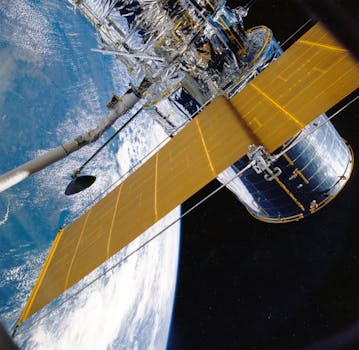
Satellite Telecommunications is rapidly evolving with recent advances shaping the industry in unprecedented ways. Beyond Earth, satellite telecommunications play a vital role in facilitating global communication, navigation, and remote sensing. The recent surge in technological innovations has transformed the satellite telecommunications landscape, enabling faster, more reliable, and efficient communication beyond our planet.
The integration of cutting-edge technologies such as artificial intelligence, blockchain, and the Internet of Things (IoT) has significantly enhanced the capabilities of satellite telecommunications. For instance, AI-powered satellites can now autonomously navigate and optimize their orbits, while blockchain-based systems ensure secure and transparent data transmission. The IoT has enabled the development of satellite-based sensor networks, facilitating real-time monitoring and data collection from remote and inaccessible areas.
One of the most significant recent advances in satellite telecommunications is the development of high-throughput satellites (HTS). HTS offer substantially higher data speeds and capacities than traditional satellites, making them ideal for applications such as broadband internet access, video streaming, and remote cloud connectivity. The introduction of HTS has also paved the way for the widespread adoption of satellite-based services in industries such as aviation, maritime, and rural connectivity.
In addition to HTS, the emergence of small satellite constellations has revolutionized the satellite telecommunications industry. Small satellites, also known as CubeSats, are compact, low-cost, and highly efficient satellites that can be launched in large numbers to form constellations. These constellations enable global coverage, providing seamless and uninterrupted communication services to users around the world. Small satellite constellations have also democratized access to space, allowing new players to enter the market and driving innovation through competition.
The growing demand for satellite-based services has also driven the development of advanced ground infrastructure. Modern ground stations are now equipped with sophisticated antennas, transceivers, and signal processing systems, enabling faster and more reliable communication with satellites. The introduction of phased array antennas and GaN-based amplifiers has significantly improved the performance and efficiency of ground stations, reducing costs and increasing throughput.
As the satellite telecommunications industry continues to evolve, we can expect even more exciting innovations and developments. The integration of 5G and satellite communications is expected to enable seamless and ubiquitous connectivity, bridging the gap between terrestrial and space-based networks. The development of reusable launch vehicles and advanced propulsion systems will further reduce the cost of access to space, making satellite telecommunications more accessible and affordable for a wider range of applications.
In conclusion, recent advances in satellite telecommunications are transforming the way we communicate beyond Earth. From the development of HTS and small satellite constellations to the emergence of advanced ground infrastructure and innovative technologies, the industry is poised for unprecedented growth and innovation. As we continue to push the boundaries of what is possible in space, we can expect satellite telecommunications to play an increasingly vital role in shaping our connected future.
The future of satellite telecommunications holds much promise, with potential applications in fields such as space exploration, environmental monitoring, and disaster response. As we move forward, it is essential to address the challenges and complexities associated with satellite telecommunications, such as regulatory frameworks, spectrum management, and cybersecurity. By working together to overcome these challenges, we can ensure that satellite telecommunications continue to thrive and support the growth of a more connected and interconnected world.





